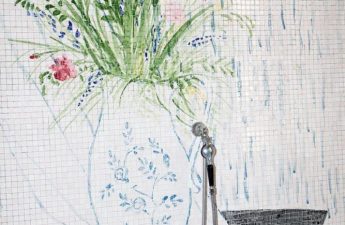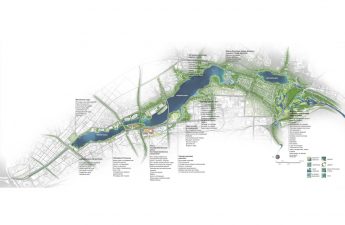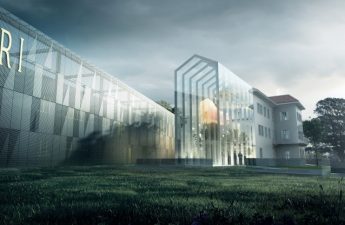The English are the lucky owners of not only the mostbeautiful gardens, but also the smallest houses in Western Europe. We decided to find out how the British manage to use every meter wisely, and chose three of the most beautiful and ergonomic small-area houses built or renovated in the last few years. In this article - all the details The Royal Institution of British Architects (RIBA) made a sensational statement: the smallest houses in Western Europe are built in England. The average area is 85 square meters for a family of three. For comparison: in Holland this figure is 115 square meters, and in Denmark - 137. Architects are divided into two camps. Some believe that the British are humiliating their dignity, and scold the government for high property taxes. And some, on the contrary, find many advantages in the new trend that will push the development of both construction technologies and architecture and design in general. Ric Frankland, Dwelle.ings, Manchester: — We can complain about the crisis, lack of funds and all the rest as much as we want. But there is another way to look at this process. I compare our tiny houses with modern car engines: the best and most powerful technologies need to be placed in the smallest space, and so that they work an order of magnitude better than the previous ones. Look, modern tiny houses consume a minimum of energy, cost owners half as much, allow the use of "green technologies", and most importantly, force designers to think about the most efficient use of every useful centimeter. dwelle.co.uk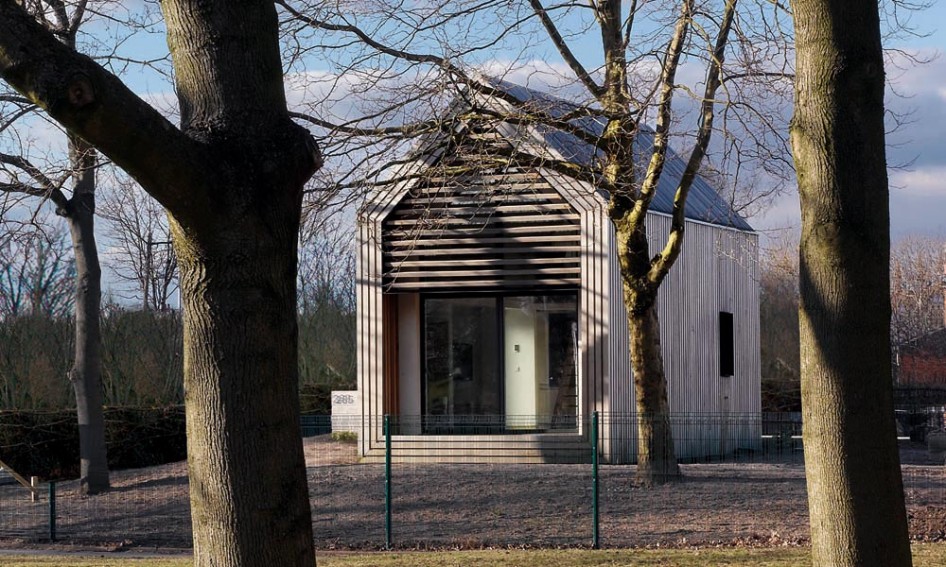 project dwelle.ing, 45 sq.m.
project dwelle.ing, 45 sq.m.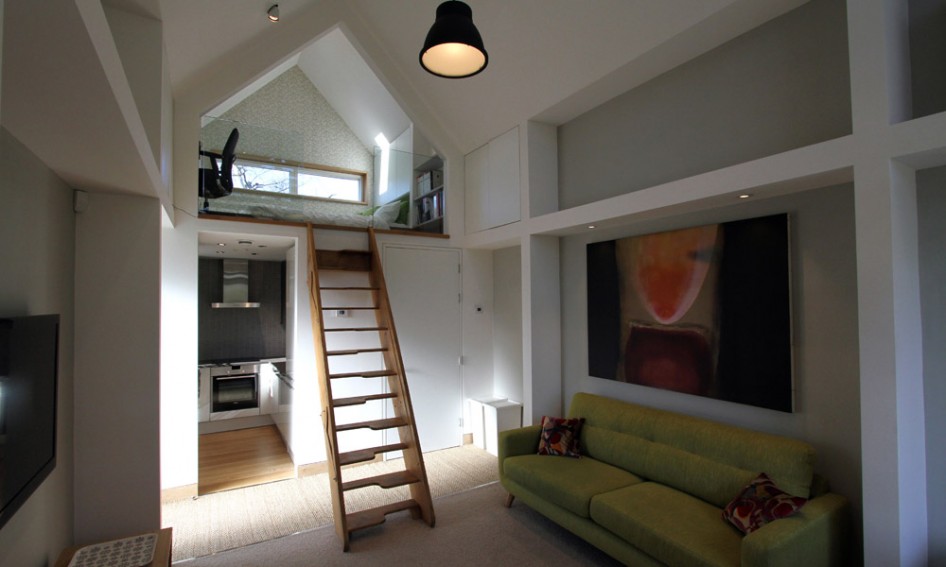 project dwelle.ing, 45 sq.m.
project dwelle.ing, 45 sq.m.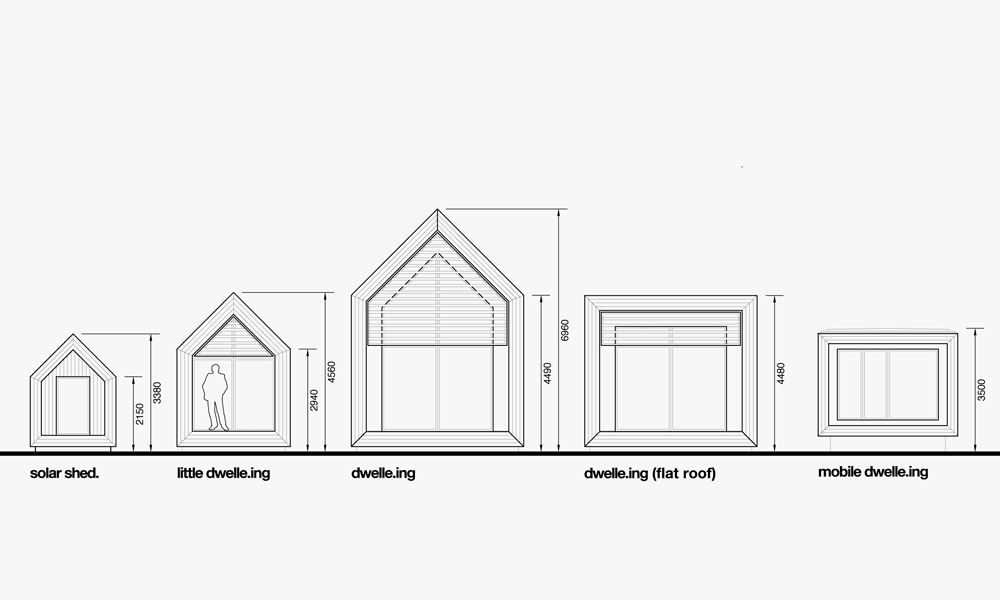 A typical English micro-house project isan open-plan space, or into the natural environment, with maximum access to light and air due to large windows, usually with an unusual and effective design that pays for itself through significant savings on utility bills - up to 80 percent compared to a traditional home.
A typical English micro-house project isan open-plan space, or into the natural environment, with maximum access to light and air due to large windows, usually with an unusual and effective design that pays for itself through significant savings on utility bills - up to 80 percent compared to a traditional home.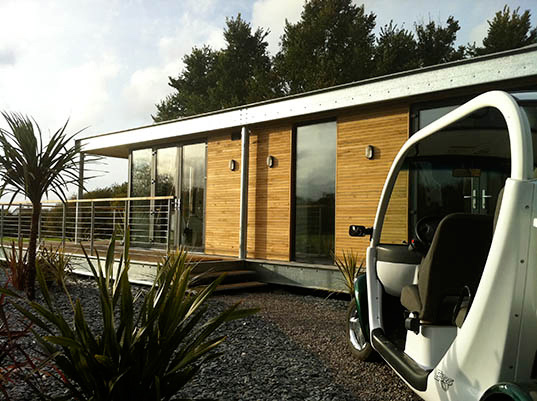
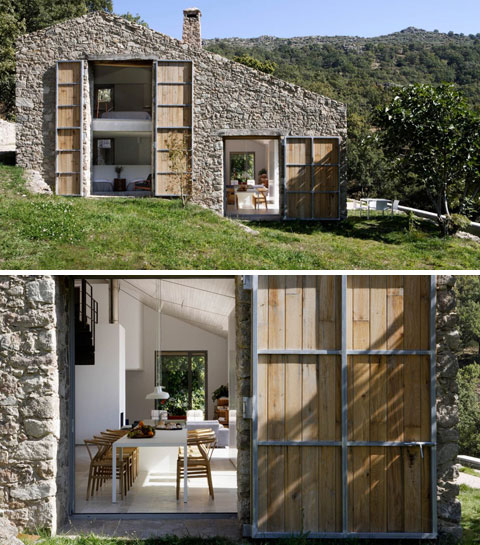
 Fight fire with fire:the narrowest house in London Neighbours in Clapham, an area in south-west London, call it the wedge house. Only 69 square metres of total floor space. Useful – half as much as any ordinary house, because this house is one of the narrowest in Europe. Only 2.4 metres wide. Three people live in the house: Tom and Sara Tidbury and their cat Arnold.
Fight fire with fire:the narrowest house in London Neighbours in Clapham, an area in south-west London, call it the wedge house. Only 69 square metres of total floor space. Useful – half as much as any ordinary house, because this house is one of the narrowest in Europe. Only 2.4 metres wide. Three people live in the house: Tom and Sara Tidbury and their cat Arnold. The house is located in a historical building,"protected" area of London. The external facade, which faces the street, should remain unchanged. But the pitched roof allows to extend and continue the house towards the inner courtyard and garden. Which is what was done in the end.
The house is located in a historical building,"protected" area of London. The external facade, which faces the street, should remain unchanged. But the pitched roof allows to extend and continue the house towards the inner courtyard and garden. Which is what was done in the end.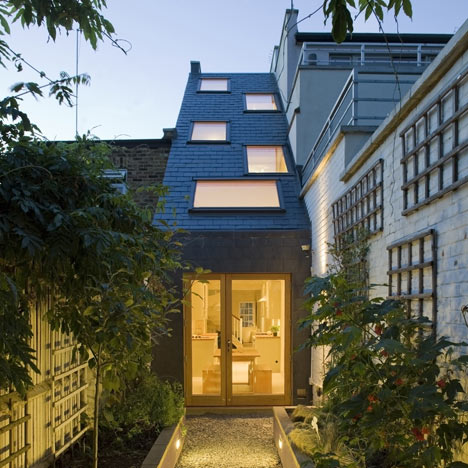 Tom and Sarah Tidbury, owners:— Guests who come to our house for the first time are always surprised by how big and spacious it actually is. From the outside it seems like we really do live in a shoebox. But that's not quite true, as you can see.
Tom and Sarah Tidbury, owners:— Guests who come to our house for the first time are always surprised by how big and spacious it actually is. From the outside it seems like we really do live in a shoebox. But that's not quite true, as you can see.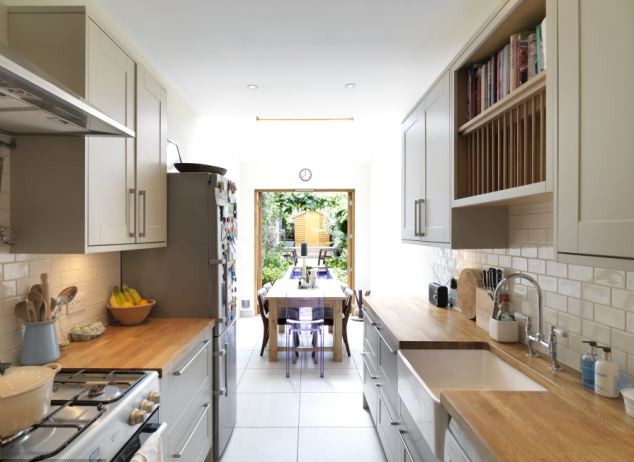 Tom and Sarah bought their house in 2009.It was their first property, they had little money and Clapham was home to all their friends and favourite bars. So they bought the only house they could afford where they wanted to live and decided to turn it into their dream home. To do this, Tom turned to a school friend who had by then become a successful architect. His friend suggested rebuilding the house towards the garden, significantly widening and lengthening it, but not changing the configuration of the facade, since this is prohibited by law. As a result, Tom and Sarah effectively had an extra room on each of the three floors.
Tom and Sarah bought their house in 2009.It was their first property, they had little money and Clapham was home to all their friends and favourite bars. So they bought the only house they could afford where they wanted to live and decided to turn it into their dream home. To do this, Tom turned to a school friend who had by then become a successful architect. His friend suggested rebuilding the house towards the garden, significantly widening and lengthening it, but not changing the configuration of the facade, since this is prohibited by law. As a result, Tom and Sarah effectively had an extra room on each of the three floors.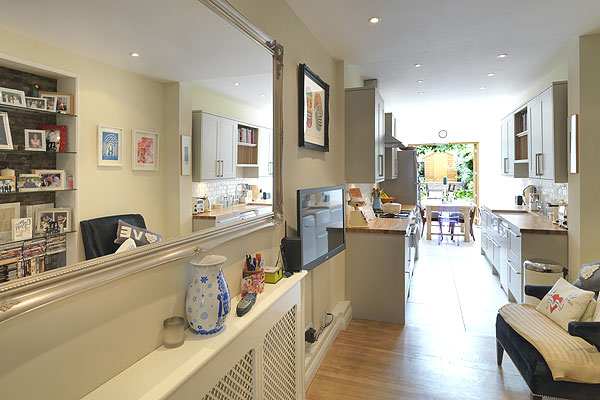 It was decided to turn the first one into a common end-to-endopen space. Now the front door leads directly into the living room, which flows into the kitchen and dining room. In front of the door is a small hall with storage shelves, from floor to ceiling. At the other end are glass doors that lead to the garden. Thanks to this solution, the house is always full of light, even on the gloomiest and foggiest days.
It was decided to turn the first one into a common end-to-endopen space. Now the front door leads directly into the living room, which flows into the kitchen and dining room. In front of the door is a small hall with storage shelves, from floor to ceiling. At the other end are glass doors that lead to the garden. Thanks to this solution, the house is always full of light, even on the gloomiest and foggiest days.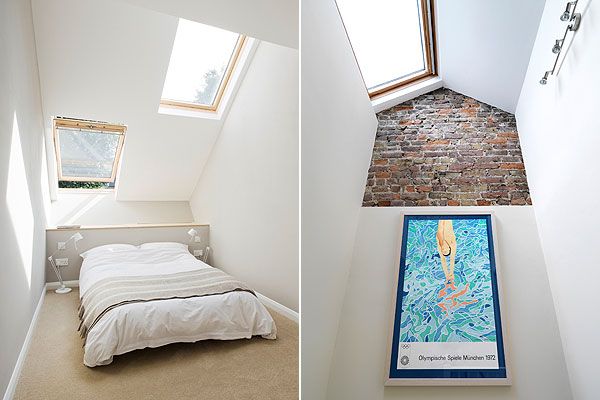 On the next floor there is a laundry room with a boiler room andguest bedroom. The main, master bedroom is right under the roof. And now there is enough space for a normal double bed, which previously did not fit here. Now there is even a small wardrobe - custom-made, however, from furniture plywood - and a full bathroom.
On the next floor there is a laundry room with a boiler room andguest bedroom. The main, master bedroom is right under the roof. And now there is enough space for a normal double bed, which previously did not fit here. Now there is even a small wardrobe - custom-made, however, from furniture plywood - and a full bathroom.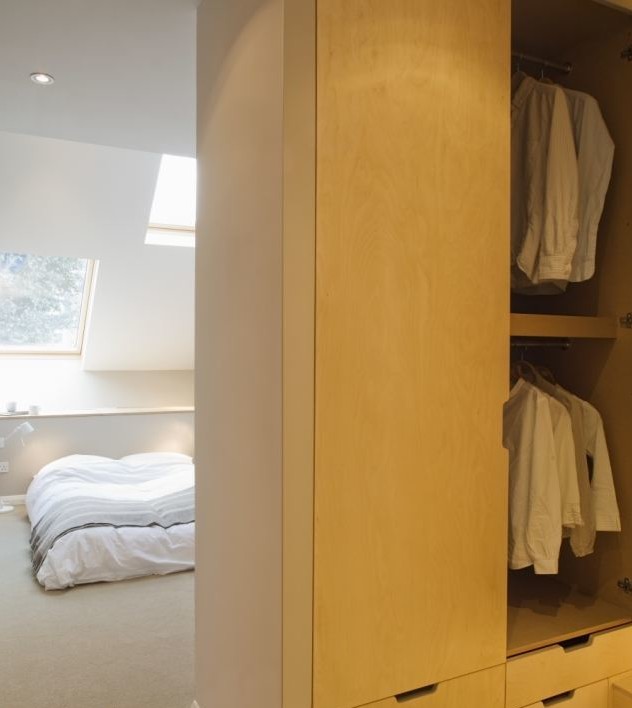
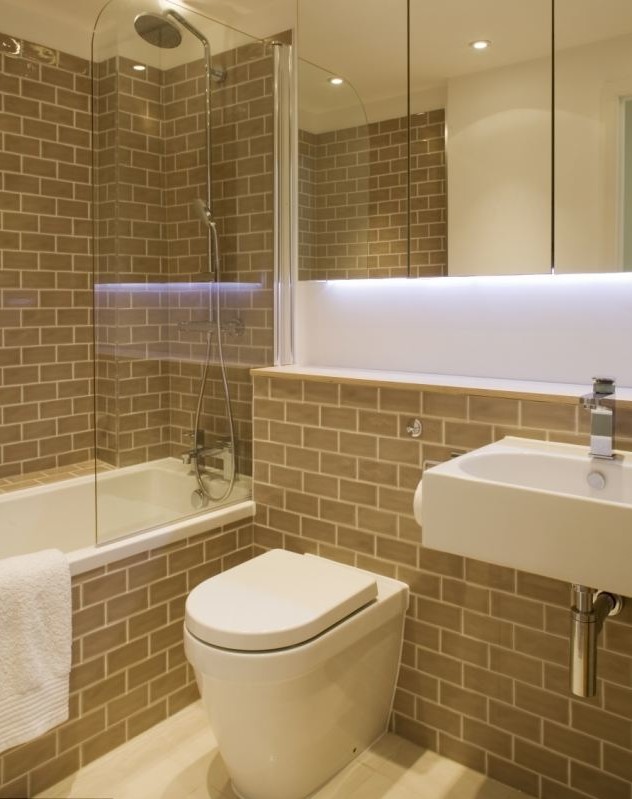 A steep roof that looks like a ski slope(as Tom and Sarah call it), leaves plenty of space in the corners for storage systems. The dormer windows make the staircase bright and make it seem more spacious than it actually is. Tom and Sarah recall that they didn’t consider this house as a permanent home when they bought it. But for six years now, they have been living in it so comfortably and happily that they have never thought about moving – it’s very convenient for them. The house cost 430 thousand pounds sterling. Another 90 thousand were spent on renovations. Now realtors estimate the house at about 800-850 thousand pounds.
A steep roof that looks like a ski slope(as Tom and Sarah call it), leaves plenty of space in the corners for storage systems. The dormer windows make the staircase bright and make it seem more spacious than it actually is. Tom and Sarah recall that they didn’t consider this house as a permanent home when they bought it. But for six years now, they have been living in it so comfortably and happily that they have never thought about moving – it’s very convenient for them. The house cost 430 thousand pounds sterling. Another 90 thousand were spent on renovations. Now realtors estimate the house at about 800-850 thousand pounds.
 Million dollar house 62 square meters in Hackney,working-class area of London's East End, cost its owners 275,000 pounds in 2006. The reconstruction and renovation took another 80,000 pounds and six months of work. The house is now valued at around a million. But the owners are not planning to part with it. The house, remodeled by a young architect for his family, has become the calling card of his architectural firm - an advertisement in brick, glass and metal.
Million dollar house 62 square meters in Hackney,working-class area of London's East End, cost its owners 275,000 pounds in 2006. The reconstruction and renovation took another 80,000 pounds and six months of work. The house is now valued at around a million. But the owners are not planning to part with it. The house, remodeled by a young architect for his family, has become the calling card of his architectural firm - an advertisement in brick, glass and metal.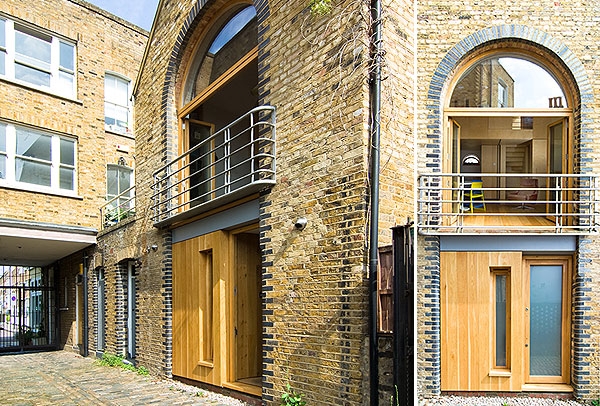 The English have a saying:"Get the house, get the girl." In the case of architect George Bradley, it happened literally. On the day he moved into a dark, cramped house in the centre of Hackney, he met a pretty Danish woman, Helen, on the street, who was looking for a place to live nearby. She eventually became his wife, and later the mother of their daughter, Ilaria.
The English have a saying:"Get the house, get the girl." In the case of architect George Bradley, it happened literally. On the day he moved into a dark, cramped house in the centre of Hackney, he met a pretty Danish woman, Helen, on the street, who was looking for a place to live nearby. She eventually became his wife, and later the mother of their daughter, Ilaria.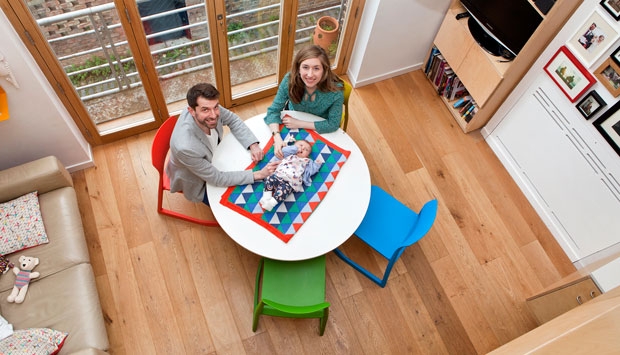 George Bradley, architect Bradley Van DerStraeten: - My agent laughed at me when I announced the budget I intended to spend on the purchase. They gave me the house without any haggling - it seemed so awful to everyone. But even then I looked at it with the eyes of an architect. And I decided that for that kind of money it was practically a steal. We quickly shook hands. b-vds.co.uk
George Bradley, architect Bradley Van DerStraeten: - My agent laughed at me when I announced the budget I intended to spend on the purchase. They gave me the house without any haggling - it seemed so awful to everyone. But even then I looked at it with the eyes of an architect. And I decided that for that kind of money it was practically a steal. We quickly shook hands. b-vds.co.uk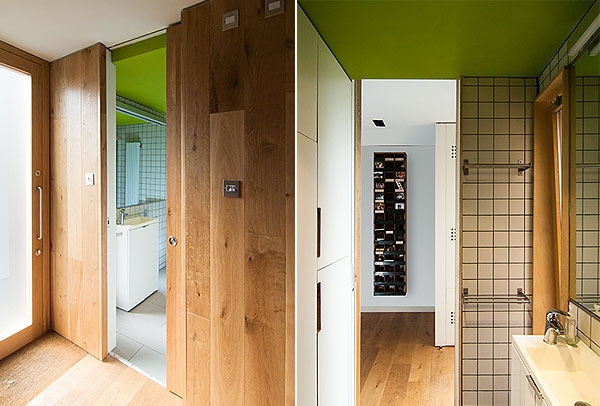 A little earlier George met someone just like him,young architect Ewald Van der Straeten, tired of working for large companies. Both wanted to do something unusual, but close to the needs of ordinary people. And they decided to start with themselves, or more precisely, with George. Planning and fundraising took three years. In fact, the house had no advantages other than a granite-faced basement and a brick facade. Two tiny rooms on each of the two lower floors and a dark bedroom hidden under the eaves at the very roof. There were doors everywhere and an inconvenient spiral staircase in the very corner. To save money, they decided to do everything themselves: Helen was interested in trying, and George and Ewald decided to gain invaluable construction experience, important for their profession.
A little earlier George met someone just like him,young architect Ewald Van der Straeten, tired of working for large companies. Both wanted to do something unusual, but close to the needs of ordinary people. And they decided to start with themselves, or more precisely, with George. Planning and fundraising took three years. In fact, the house had no advantages other than a granite-faced basement and a brick facade. Two tiny rooms on each of the two lower floors and a dark bedroom hidden under the eaves at the very roof. There were doors everywhere and an inconvenient spiral staircase in the very corner. To save money, they decided to do everything themselves: Helen was interested in trying, and George and Ewald decided to gain invaluable construction experience, important for their profession. The main internal material is wood.The staircase now had to be centered so that the widened doorways would create a feeling of spaciousness and open plans. The flooring was made of construction oak boards, which were processed by hand. The regular entrance door was replaced with a taller one, glazed with frosted glass, and above it, a huge balcony window was installed, taking up half the wall, significantly adding light and space.
The main internal material is wood.The staircase now had to be centered so that the widened doorways would create a feeling of spaciousness and open plans. The flooring was made of construction oak boards, which were processed by hand. The regular entrance door was replaced with a taller one, glazed with frosted glass, and above it, a huge balcony window was installed, taking up half the wall, significantly adding light and space.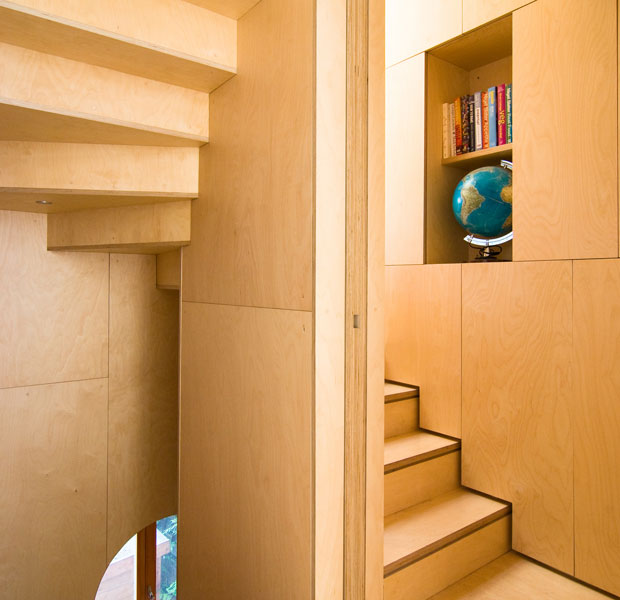 Designed and made from the same plywoodkitchen. Only the countertop was specially ordered. It is made of Corian - an artificial stone, and gives their creation an expensive and stylish look. Secret and obvious cabinets and cupboards are hidden throughout the house - hidden under the steps of the stairs, between the roof slopes, occupying narrow and long piers.
Designed and made from the same plywoodkitchen. Only the countertop was specially ordered. It is made of Corian - an artificial stone, and gives their creation an expensive and stylish look. Secret and obvious cabinets and cupboards are hidden throughout the house - hidden under the steps of the stairs, between the roof slopes, occupying narrow and long piers. Each element is perfectly adjusted in shape andsize, and therefore the storage systems are no different from a regular wall or opening. This makes the house visually larger than it actually is, and much more convenient than it was before the team's intervention.
Each element is perfectly adjusted in shape andsize, and therefore the storage systems are no different from a regular wall or opening. This makes the house visually larger than it actually is, and much more convenient than it was before the team's intervention.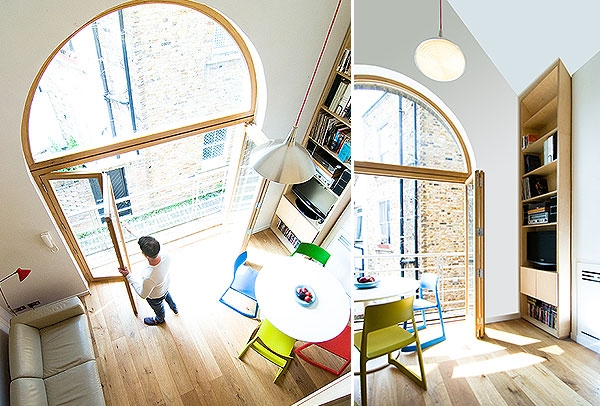 Hemp Cottage in Northern Ireland In 2008In 2008, this cottage cost its owner only 100 thousand pounds: by English standards, almost free - major repairs to most London apartments cost much more. From the road, the house is no different from old country houses, although it is a typical new building. But not a simple one. The author of the project, Scottish architect Tom Wooley is a member of the Royal Academy of Architecture, a professor at the University of Scotland and a laureate of all possible architectural awards in Europe. The project was developed for a 90-year-old customer who wanted to spend the rest of his life in harmony with nature. It is not surprising that the house still remains one of the symbols of British "green" construction.
Hemp Cottage in Northern Ireland In 2008In 2008, this cottage cost its owner only 100 thousand pounds: by English standards, almost free - major repairs to most London apartments cost much more. From the road, the house is no different from old country houses, although it is a typical new building. But not a simple one. The author of the project, Scottish architect Tom Wooley is a member of the Royal Academy of Architecture, a professor at the University of Scotland and a laureate of all possible architectural awards in Europe. The project was developed for a 90-year-old customer who wanted to spend the rest of his life in harmony with nature. It is not surprising that the house still remains one of the symbols of British "green" construction.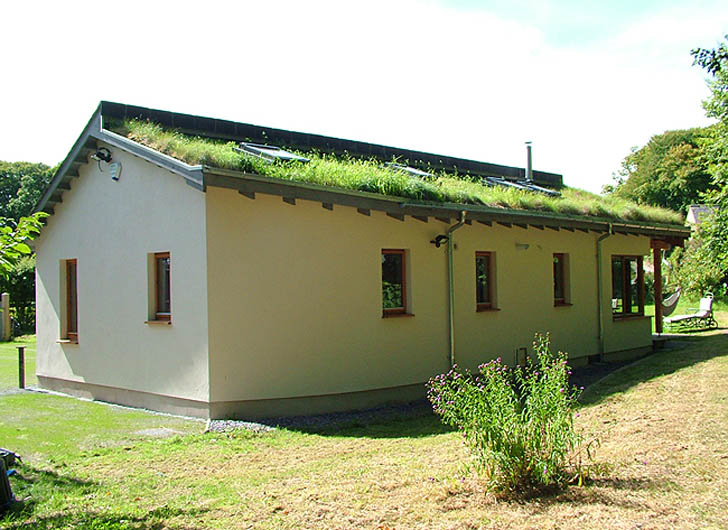
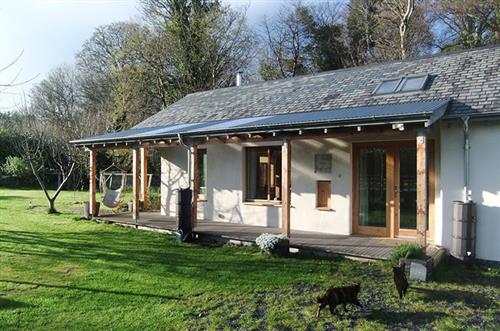 70 square meters of total area, includingexternal terraces, built entirely from natural materials. The house is located in the middle of an apple grove, on the banks of the fast Irish river Ballynahinch, which is famous for its excellent salmon fishing.
70 square meters of total area, includingexternal terraces, built entirely from natural materials. The house is located in the middle of an apple grove, on the banks of the fast Irish river Ballynahinch, which is famous for its excellent salmon fishing.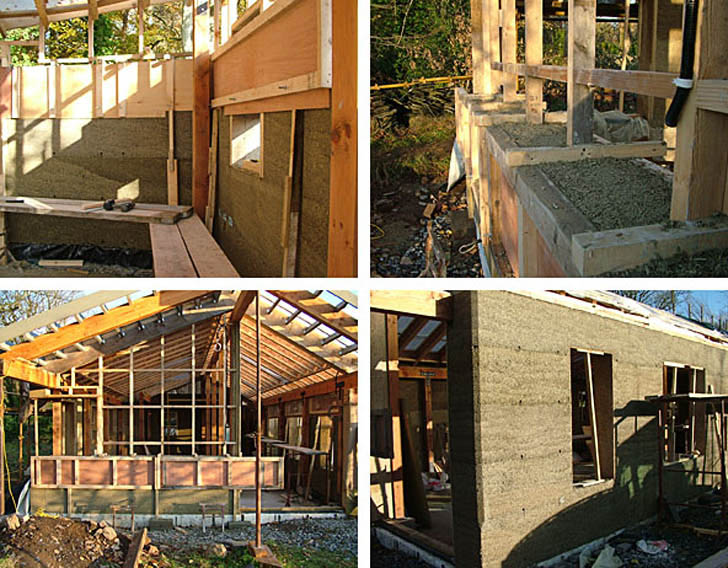
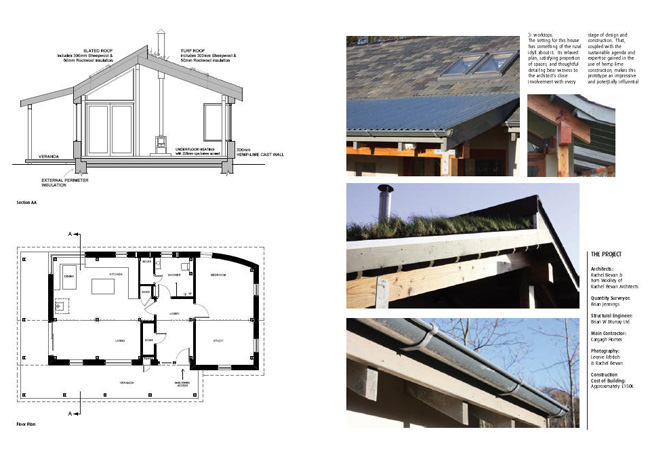 Tom Wooley, architect, Rachel Bevan Architects:— It was our first attempt to find a way to build low-carbon, energy-efficient houses using only natural materials, affordable and simple design. The experience we gained then is still used in the company today. The mixture of hemp and lime that we used for construction turned out to be an extremely successful technological solution. bevanarchitects.com
Tom Wooley, architect, Rachel Bevan Architects:— It was our first attempt to find a way to build low-carbon, energy-efficient houses using only natural materials, affordable and simple design. The experience we gained then is still used in the company today. The mixture of hemp and lime that we used for construction turned out to be an extremely successful technological solution. bevanarchitects.com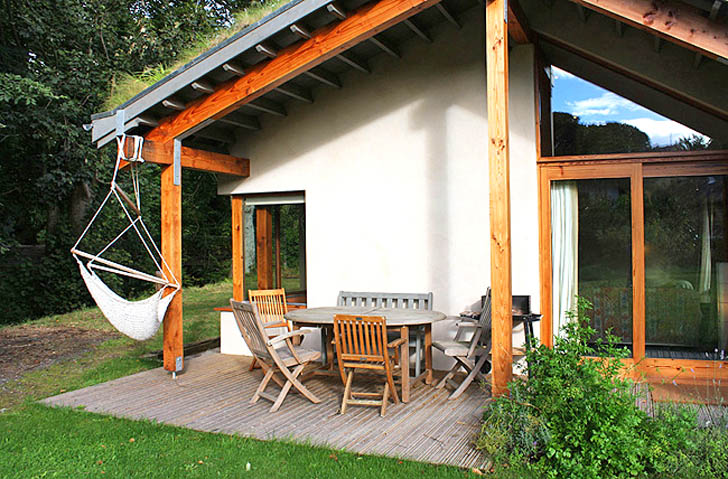 The building frame is assembled from spruce timber, the roofcovered with turf and 350 mm thick sheep wool insulation material, the walls are assembled from hemp-lime slabs. This turned out to be an amazing material with exceptional sound and heat insulation properties. The structure is enclosed in it on one side like a cocoon, and on the other side it lets air through.
The building frame is assembled from spruce timber, the roofcovered with turf and 350 mm thick sheep wool insulation material, the walls are assembled from hemp-lime slabs. This turned out to be an amazing material with exceptional sound and heat insulation properties. The structure is enclosed in it on one side like a cocoon, and on the other side it lets air through.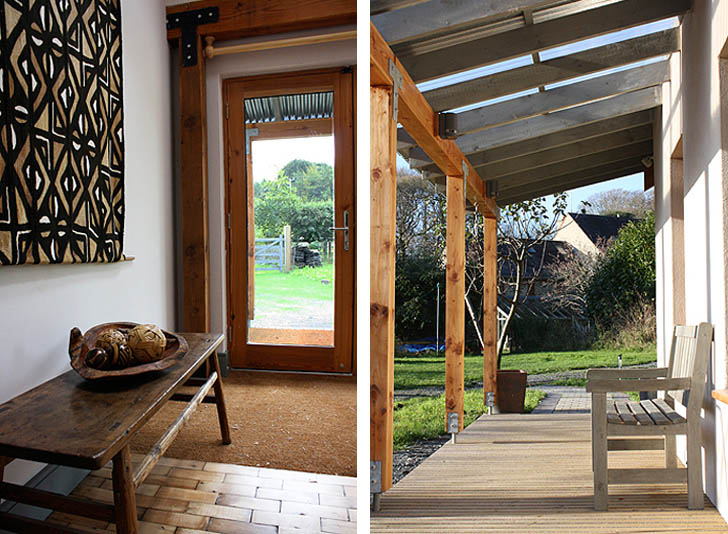 Woolie swears that no construction was doneNot a gram of plastic was used - only local renewable materials. The climate in Ireland is difficult - the summer is short and quite cold, and in the off-season there is very high humidity and strong, chilly winds. But the hemp cottage is not afraid of such tests, despite the large windows in the southern part of the building and in the roof and the lack of central heating. The radiators there are replaced by an ordinary potbelly stove, and it is enough even in winter - the walls retain heat perfectly.
Woolie swears that no construction was doneNot a gram of plastic was used - only local renewable materials. The climate in Ireland is difficult - the summer is short and quite cold, and in the off-season there is very high humidity and strong, chilly winds. But the hemp cottage is not afraid of such tests, despite the large windows in the southern part of the building and in the roof and the lack of central heating. The radiators there are replaced by an ordinary potbelly stove, and it is enough even in winter - the walls retain heat perfectly.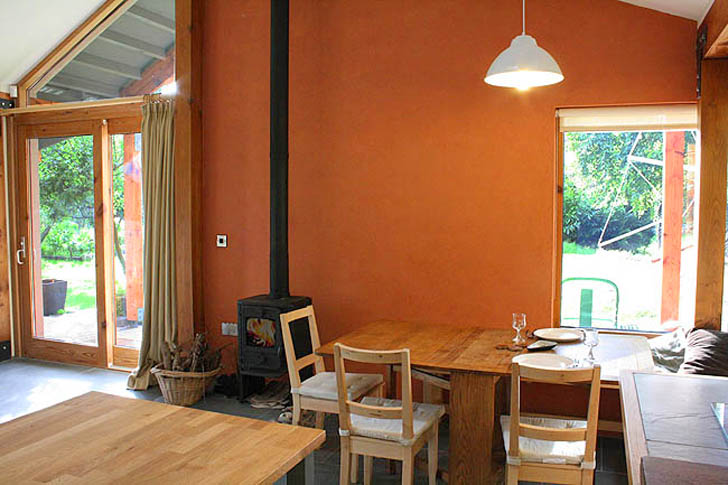 Life in such a space is not only quiteconvenient, cheap, but also healthy. For two years now, the cottage has been used for renting to ecotourism and fishing enthusiasts. They mostly come with their families. The English believe that living in such a house helps children feel close to nature and teaches useful rural skills, such as lighting a stove, picking and drying apples, etc. Those who risk cycling or walking to the cottage get big discounts.
Life in such a space is not only quiteconvenient, cheap, but also healthy. For two years now, the cottage has been used for renting to ecotourism and fishing enthusiasts. They mostly come with their families. The English believe that living in such a house helps children feel close to nature and teaches useful rural skills, such as lighting a stove, picking and drying apples, etc. Those who risk cycling or walking to the cottage get big discounts.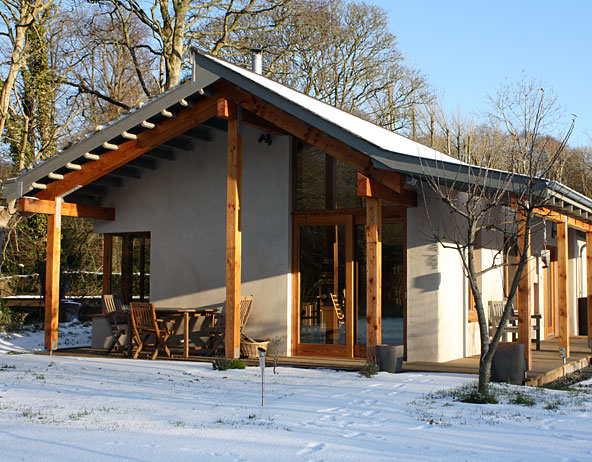
The smallest houses in England: 3 examples of functional planning of a small area – etk-fashion.com

